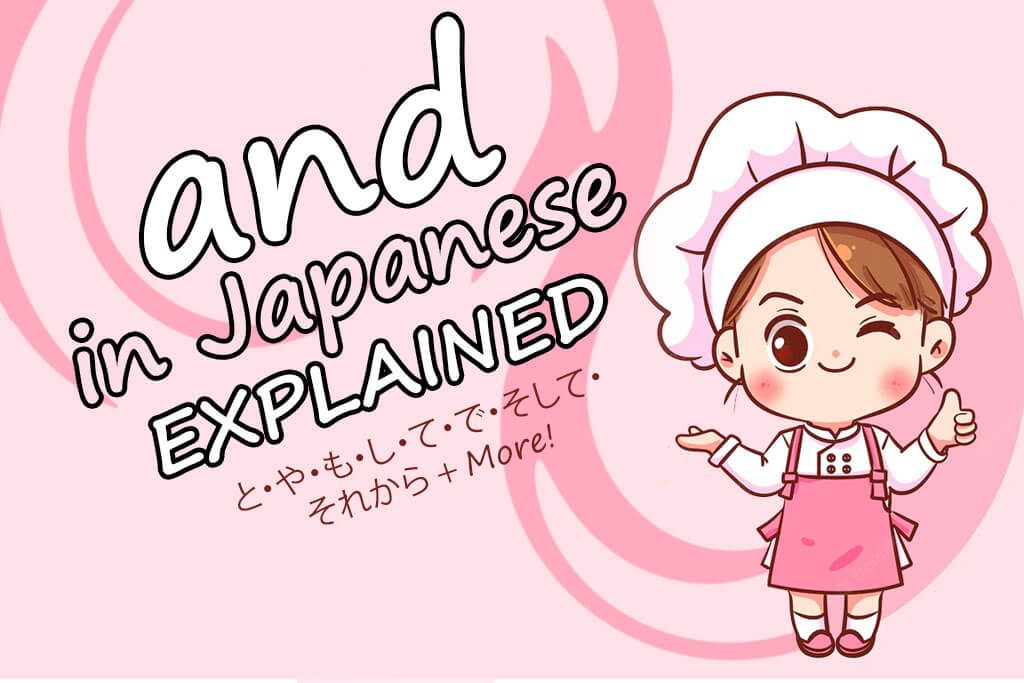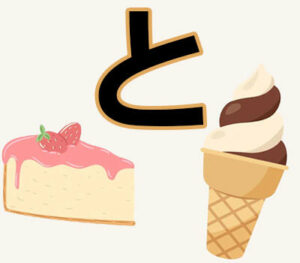There are surprisingly many ways to say “and” in Japanese.
Which one you require will depend on what you are linking.
Depending on whether you are connecting nouns, verbs, nouns, clauses, or sentences, you will require a different Japanese word to convey “and.”
There is not a generic single word for “and” in Japanese that can be used for all situations.
With that said, one of the simplest ways to say “and” in Japanese is with と (to).
Use と (to) to connect a number of nouns together.
Simply insert と (to) in between two nouns to connect them.
- Cats and dogs.
猫と犬。
neko to inu.
You can increase the number of items by inserting と (to) in between each noun.
- Red and blue and green.
赤と青と緑。
aka to ao to midori.
The way you connect verbs, adjectives, clauses and sentences with “and” in Japanese are all different from each other.
This ultimate guide lists and explains all the ways to say “and” in Japanese.
The content in this guide is tailored for both beginners and intermediate learners alike.
All entries are coupled with multiple examples to illustrate each use of “and”. Audio has been provided for a reference on pronunciation!
Table of Contents
And in Japanese: Linking Nouns With と (to)
- [noun] and [noun].
[noun] と [noun]。
[noun] to [noun].
The easiest way to connect two things together in Japanese is with と (to).
You can insert と (to) in between two nouns to connect them. You cannot connect adjectives, verbs, clauses etc using と (to).
Linking two nouns together with と (to) essentially connects them together as pairs.
- ケーキとアイスクリームが好き.
ke-ki to aisukuri-mu ga suki.
I like cake and ice cream.
In the above example, と (to) functions the same as “and” does in English. と (to) comes between the words “cake” and “ice cream”, to signify them as being related.
The relationship these two connected words share is, in this case, explained as being the two objects that a person likes.
と (to) to say “and” in Japanese Examples
- 彼と彼女は付き合ってる。
kare to kanajo wa sukiatteru.
He and she are dating.
Related: How to say I Like You in Japanese [Ultimate Guide].
You can continue to extend the list of related nouns as necessary. However, と (to) is generally used to link only a fixed number of items.
- 日本とカナダとアメリカに行きたい。
nihon to kanada to amerika ni ikitai.
I want to go to Japan and Canada and America.
In Japanese, you can use と (to) to expand a list of connected nouns.
As the example illustrates, continuously connecting nouns together with と (to) can become repetitive.
It’s very similar to if you were to connect multiple items together using “and” in English. Therefore it’s generally more natural to refrain from listing a massive number of nouns.
As a quick side note, Japanese nouns don’t require any preceding articles such as “a” or “the” like in English.
To say you went to the mountains and the beach for summer you can simply say:
- 山とビーチに行った。
yama to bi-chi ni itta.
I went to the mountains and the beach.
In these examples, Japanese is very simple. You do not need any “the” before the words “mountains” and “beach”, as you would in English.
Furthermore, you do not need to use pronouns either! This is because it’s much more natural to omit pronouns when speaking Japanese.
Therefore, specifying that you, the speaker, went to the mountains and beach with “I” is unnecessary.
The literal translation of the above example would be “went to mountains and beach”, however it’s understood as “I went to the mountains and the beach” in Japanese.
Listing Items with “and” in Japanese
There are a few occasions when listing consecutive nouns using と (to) in Japanese is necessary.
- LサイズとMサイズとSサイズとどれがいいですか。
L saizu to M saizu to S saizu to dore ga ii desu ka.
Which would you like? The large size, the medium size, or the small size?
You can use と (to) to list items like the above example. Using と (to) like so functions similarly to how we list related items using commas in English.
When you present a list of options to choose from, use と (to) to separate them.
In this case, the final と (to) functions similarly to how we use “or” in English. However, as you are still presenting a list of related items, you connected them with と (to).
There are many ways to say “or” in Japanese which are detailed and explained in the ultimate guide below.
Related: How to say Or in Japanese [Ultimate Guide].
Linking Nouns With や (ya)
- [noun] and [noun].
[noun] や [noun]。
[noun] ya [noun].
Connecting nouns with や (ya) is another way to say “and” in Japanese.
Insert や (ya) in between two nouns to list them.
Similarly to と (to), や (ya) is also used only with nouns. や (ya) cannot be used with adjectives, verbs and clauses etc.
However, while と (to) is used to list a fixed number of items, や (ya) indicates a non-exhaustive list of similar nouns.
In short, use や (ya) to connect multiple nouns together in a list. Using や (ya) implies that there are more items in the list that you have not mentioned.
や (ya) to say “and” in Japanese Examples
や (ya) adds the nuance of “and so on…” or “…and that” to the end of sentences. For instance:
- リンゴやバナナが好きです。
ringo ya banana ga suki desu.
I like apples and bananas (among other things).
In the above example, や (ya) connects two nouns (apples and bananas) together in a list. や (ya) also implies that there is a variable or unknown length to the list.
Therefore when you use や (ya), you’re implying that the nouns you’ve listed are not final. There are more related nouns that are unsaid.
Sometimes や (ya) is paired with など (nad0), a word that means “etc” in Japanese.
など (nad0) typically comes after the last noun in the list, similar to English.
- 今朝、卵やベーコンなどを食べた。
kesa, tamago ya be-kon nado wo tabeta.
This morning, I ate eggs and bacon etc.
In the above example, など (nado), meaning “etc” is inserted after the final noun (bacon) in the list.
Linking Nouns With も (mo)
- [noun] and also [noun].
[noun] も [noun]。
[noun] mo [noun].
You can also link nouns together with も (mo) to say “and” in Japanese.
The biggest difference between も (mo) vs と (to) and や (ya), explained above, is that も (mo) is analogous to meaning “and also” in English.
In other words, use も (mo) when making a further addition to a statement. Directly translated, も (mo) means “also” in Japanese.
も (mo) to say “and” in Japanese Examples
- 猫も犬もが好き。
neko mo inu mo suki.
I like both cats and dogs.
An easy way to remember how to use も (mo) when saying “and” in Japanese is to think of the first も (mo) as meaning “both” and the second one as meaning “and”.
- ピザもアイスクリームも食べたい。
piza mo aisukuri-mu mo tabetai.
I want to eat both pizza and ice cream.
も (mo) emphasises that both nouns in the statement are of equal importance.
Not one of the nouns is perceived to be of higher significance than the other.
You can also use a single も (mo) in a sentence when you want to say “also” in Japanese.
For instance:
- 私もわからない。
watashi mo wakarani.
I also have no idea.
A single も (mo) indicates that something is in the same situation.
In the above example specifically, も (mo) indicates that the speaker has no idea, in addition to someone else who may have previously expressed their uncertainty before.
Related: How to say I Don’t Know in Japanese [Ultimate Guide].
And in Japanese: Linking Verbs With Te-Form
To link verbs with “and” in Japanese, you need to conjugate them into the grammatical structure called the te-form.
Japanese sentences typically end with the verb. The te-form allows one to bypass that rule and connect a verb to another.
In short, the te-form is necessary to connect simultaneous actions together.
Te-form conjugated verbs typically end in て (te) or で (de), hence the name, the te-form.
Te-Form to say “and” in Japanese Explanation
As a preliminary example:
- 朝ごはんを食べて学校に行った。
asagohan wo tabete, gakkou ni itta.
I ate breakfast and went to school.
The te-form connects verbs into a sequence that usually follows an order.
Using the above example, the action that comes first is “ate breakfast”. Although in this example it may seem obvious which order something is done in, in other cases it may not.
For instance:
- 本を読んで映画を見た。
hon wo yonde eiga wo mita.
I read a book and then watched a movie.
The sequence in which actions or events take place is clarified by the te-form.
Therefore we can say with 100% certainty that this person read a book before watching the movie.
Hence, the te-form functions similarly to how “and then” does in English.
How To Make the Te-Form
Each verb in Japanese is conjugated differently.
There are three different ways to conjugate verbs. Therefore they are separated into three groups, corresponding to their different conjugational rules.
These three are:
- Group 1 (godan verbs).
- Group 2 (ichidan verbs).
- Group 3 (irregular verbs).
| Group Type | Masu-Stem | Dictionary Form | Te-Form |
|---|---|---|---|
| Godan (Group 1) | 会います 読みます 聞きます 飲みます 書きます 話します 死にます 思います 泳ぎます | 会う 読む 聞く 飲む 書く 話す 死ぬ 思う 泳ぐ | 会って 読んで 聞いて 飲んで 書いて 話して 死んで 思って 泳いで |
| Ichidan (Group 2) | 食べます 起きます 寝ます 見ます 浴びます | 食べる 起きる 寝る 見て 浴びる | 食べて 起きて 寝て 見て 浴びて |
| Irregular (Group 3 | します 来ます 行きます | する 来る 行く | して 来て 行って |
Group 1 (Godan Verbs)
Verbs in group 1 (godan verbs) are conjugated in different ways. Here are the rules on how it works.
Replace the final kana of each verb with its te-form conjugation.
Verbs categorised in group 1 that have their final hiragana as う (u), つ (tsu) or る (ru) when in the dictionary form will always become って (tte) when conjugated into the te-form.
The te-form of the verb 会う (au), meaning “to meet” is:
- 会う – 会
う– 会って
Verbs that have their final hiragana as む (mu), ぶ (bu) or ぬ (nu) when in the dictionary form will always become んで (nde) when conjugated into the te-form.
The te-form of the verb 読む (yomu), meaning “to read” is:
- 読む – 読
む– 読んで
Verbs that have their final hiragana as す (su) when in the dictionary form will always become して (shte) when conjugated into the te-form.
The te-form of the verb 話す (hanasu), meaning “to speak” is:
- 話す– 話す – 話して
Verbs that have their final hiragana as く (ku) when in the dictionary form will always become いて (ite) when conjugated into the te-form.
The te-form of the verb 聞く (kiku), meaning “to listen” is:
- 聞く– 聞
く– 聞いて
Verbs that have their final hiragana as ぐ (gu) when in the dictionary form will always become いで (ide) when conjugated into the te-form.
The te-form of the verb 泳ぐ (oyogu), meaning “to swim” is:
- 泳ぐ – 泳
ぐ– 泳いで
Group 2 (Ichidan Verbs)
Verbs categorised as group 2 (ichidan verbs) are the easiest to conjugate. All of these verbs end in る (ru).
However, be careful not to assume that just because a verb ends in る (ru) it’s classified as group 2! It may still fall into the group 1 category.
For help on conjugating Japanese words and what category a verb falls into I highly recommend this site.
To conjugate a group 2 verb, replace the final る (ru) with て (te).
The te-form of the verb 食べる (taberu), meaning “to eat” is:
- 食べる – 食べ
る– 食べて
Group 3 (Irregular Verbs)
Verbs in the group 3 category are classified as irregular verbs. These verbs do not follow any pattern and thus are a little more difficult to learn and remember.
There are three very important verbs to remember. Here are the special rules:
The verb 行く (iku), meaning “to go” is the first of these irregular verbs.
The te-form of this verb is:
- 行く– 行
く– 行って
The second irregular verb is 来る (kuru), meaning “to come” in Japanese.
The te-form of this verb is:
- 来る – 来
る– 来て
来る (kuru) is a tricky conjugation that will catch many beginners off guard. This is because when 来る (kuru) is conjugated into the te-f0rm the reading changes too.
Writing the word in kanji (as I have above) actually disguises this change.
The reading of 来る (kuru) changes from くる (kuru) to きて (kite) when made into the te-form.
The third irregular verb is する (suru), which means “to do” in Japanese. When する (suru) is conjugated into the te-form, the entire word changes.
The te-form of this verb is:
- する –
する– して
Te-Form to say “and” in Japanese Examples
We use the te-form to connect a verb to another word with “and” in Japanese.
The verb that follows “and” in the sequence needs to be changed into the te-form.
Remember that linking verbs with the te-form indicates a sequence of events that follow a specific order.
- ゲームをしてアニメを見た。
ge-mu wo shite anime wo mita.
I played games and watched anime.
The above example uses する (suru), the verb for “to do” in Japanese. する (suru) falls into group 3 (irregular verbs).
Therefore する (suru) becomes して (shte) when changed into the te-form.
When talking about games, use the verb する (suru) to say that you “play them”.
The te-form indicates a sequence of events using “and”. Therefore the above example implies that anime was watched after playing games.
- 死んで、諦めた。
shinde, akirameta.
I died and gave up.
The te-form for the verb 死ぬ (shinu), meaning “to die” in Japanese is 死んで (shinde).
To add context to this example, imagine that the speaker has died in a video game.
The first event that occurred was the act of dying. Following that the person proceeded to give up.
Therefore the te-form indicates that only after failing and dying did the person stop trying.
Past & Future Tense with the Te-Form
When composing a sentence by linking verbs with the te-f0rm, you may be wondering how tense is conveyed.
The only verb that needs it’s tense changed is the last verb that comes at the end of the sentence.
Every other verb you link with the te-form remain without change.
To describe an action that occurred in the past, change the final verb into the past tense.
- 東京に行ってお寿司を食べた。
toukyou ni itte osushi wo tabeta.
I went to Tokyo and ate sushi.
Conversely, if this exact sentence was in the future/present tense it, the final verb would be in the dictionary form.
- 東京に行ってお寿司を食べる。
toukyou ni itte osushi wo taberu.
I went to Tokyo and will eat sushi.
Essentially the verb 食べた (tabeta), meaning “ate” becomes 食べる (taberu), meaning “eat”, or “will eat”.
Making past tense verbs is explained in the next section.
Linking Verbs with たりたり (tari-tari)
Using the te-form to connect verbs together with “and” in Japanese implies that there is a sequence that follows an order.
To link verbs with “and” in Japanese without indicating a specific order, use the grammar point たりたり (tari tari).
In short, たりたり (tari tari) is a grammar structure that allows verbs to be connected in a sequence that is random.
For instance, if you said:
- 昨日、アニメを見たり、寝たり、ゲームをした。
kinou, anime wo mitari, netari, ge-mu wo shita.
Yesterday I watched anime, slept and played games.
The order in which these three things were completed is left vague due to たりたり (tari tari).
It’s possible that this person slept first, before watching anime and playing games.
Whereas if this sentence was made using the te-form, it would imply a stricter sequence.
たりたり (tari tari) is excellent to use when listing multiple examples.
How to Make Tari Tari
たりたり (tari tari) is a post-beginner grammar point.
This grammar point is made by conjugating verbs into the ta-form and then attaching り (ri) to the verb.
The Ta Form (past tense verbs)
The ta-form refers to dictionary-form verbs conjugated into the past tense in Japanese.
Hence, a verb in the ta-form is a verb in the past tense.
Just like with the te-form, ta-form verbs are split into three categories.
Thus, these three groups contain verbs that are conjugated differently from the verbs in other groups.
If you are in the beginner stages with verb conjugation, I strongly recommend learning the te-form first, before moving on to the ta-form.
The te-form is explained in an earlier entry above.
This is because the ta-form verbs are conjugated the exact same way as te-form verbs are. Except, instead of ending with て (te), the verbs typically end with た (ta).
Let’s look at some examples of how these verbs look in the ta-form.
| Group Type | Masu-Stem | Dictionary Form | Ta-Form |
|---|---|---|---|
| Godan (Group 1) | 会います 読みます 聞きます 飲みます 書きます 話します 死にます 思います 泳ぎます | 会う 読む 聞く 飲む 書く 話す 死ぬ 思う 泳ぐ | 会った 読んだ 聞いた 飲んだ 書いた 話した 死んだ 思った 泳いだ |
| Ichidan (Group 2) | 食べます 起きます 寝ます 見ます 浴びます | 食べる 起きる 寝る 見て 浴びる | 食べた 起きた 寝た 見た 浴びた |
| Irregular (Group 3 | します 来ます 行きます | する 来る 行く | した 来た 行った |
たりたり (tari-tari) to say “and” in Japanese Examples
To complete the conjugation of a verb into たりたり (tari tari), attach り (ri) to a verb that is in the ta-form.
To clarify, use たりたり (tari tari) to list multiple items that don’t follow a specific order.
The final verb in the たりたり (tari tari) list must always end with する (suru), the verb for “to do” in Japanese.
- ラーメンを食べたり映画を見たりする。
ra-men wo tabetari eiga wo mitari suru.
I will eat ramen and watch a movie.
In the above example, the actions of eating ramen and watching a movie are connected with たりたり (tari tari).
たりたり (tari-tari) Past Tense
- 勉強したり料理を作ったりした。
benkyou shtari ryouri wo tsukuttari shta.
I studied and cooked.
たりたり (tari tari) can also be used to link verbs with “and” in Japanese using the past tense.
To change たりたり (tari tari) into the past tense, change the mandatory する (suru) that follows the final たり (tari) into した (shta).
した (shta) is the past tense of する (suru).
A たりたり (tari tari) sentence that ends with した (shta) changes all the verbs in the sentence into the past tense (see the above example!).
And in Japanese: Linking Adjectives
There are two ways to connect adjectives with “and” in Japanese.
This is because Japanese adjectives are separated into two groups.
Japanese adjectives are either an “i-adjective” or a “na-adjective”.
Distinguishing the difference between the two is relatively simple.
An “i-adjective” is an adjective that generally ends in い (i). Whereas a “na-adjective” ends in a character that is geneerally not い (i).
All “na-adjectives” require an additional な (na) to be attached to the end of the word in certain conjugations.
| Type | Adjective | Romaji | Meaning |
|---|---|---|---|
| i-adjective | おいしい 美しい 悲しい うれしい あつい かわいい 強い 弱い 高い | oishii utsukushii kanashii ureshii atsui kawaii tsuyoi yowai takai | delicious beautiful sad happy hot cute strong weak expensive |
| na-adjective | 静か(な) 便利(な) 大切(な) 好き(な) 上手(な) 有名(な) | shizuka (na) benri (na) taisetsu (na) suki (na) jouzu (na) yuumei (na) | quiet convenient important like skillful famous |
There are a few exceptions to the rule that every adjective ending with い (i) is an “i-adjective”.
The most common one is きれい (kirei), which means “beautiful” in Japanese. Despite ending in い (i), きれい (kirei) is a “na-adjective”.
Linking Adjectives with くて (kute)
To link an “i-adjective” with “and” in Japanese, replace the final い (i) that appears in the word with くて (kute).
For instance, おいしい (oishii), which means “delicious” would become おいしくて (oishikute), which means “delicious and”.
To clarify: おいしい – おいしい – おいしくて.
All i-adjectives follow this rule of replacing the final い (i) with くて (kute).
- 悲しい – 悲しくて (sad)
- うれしい – うれしくて (happy)
- あつい – あつくて (hot)
- かわいい – かわいくて (cute)
- 強い – 強くて (strong)
You can use くて (kute) to connect i-adjectives with “and” in Japanese using this method.
くて (kute) to say “and” in Japanese Examples
- 猫はかわいくてふわふわ。
neko wa kawakikute fuwafuwa.
The cat is cute and fluffy.
In this example, replace the final い (i) in かわいい(kawaii) with くて (kute). In doing so, かわいい (kawaii) becomes かわいくて (kawaikute).
Related: How to say Or in Japanese [Ultimate Guide].
This allows multiple adjectives to be connected together.
- うれしくてすごく笑った。
ureshikute sugoku waratta.
I was happy and laughed a lot.
Note: It’s natural to omit pronouns in Japanese!
The above example uses うれしい (ureshii) the adjective for “happy”. うれしい (ureshii), becomes うれしくて (ureshikute).
Past tense can also be conveyed using くて (kute). The tense of the final word in the sentence dictates whether a sentence is past, future/present.
In the case of the above example, 笑った (waratta) is the past tense of 笑う (warau), the verb “to laugh”.
Hence, the entire sentence becomes a past tense sentence.
For a deeper explanation and additional clarity, I highly recommend this video by Miku. She explains how to connect adjectives very well.
Linking Adjectives with で (de)
To link a “na-adjective” with “and” in Japanese, simply attach で (de) to the end of the adjective.
Refer to the list above for a list of adjectives or take a look at this page for a list of the most common ones.
For instance, the “na-adjective” 静か (shizuka), meaning “quiet”, becomes 静かで (shizuka de), meaning “quiet and”.
- 便利 – 便利で (convenient)
- 大切 – 大切で (important)
- 好き – 好きで (like)
- 有名 – 有名で (famous)
The added で (de) to the end of these adjectives functions as “and”.
で (de) to say “and” in Japanese Examples
You can link multiple na-adjectives together with で (de).
- 静かで平和。
heiwa de shizuka.
Peace and quiet.
Inserting で (de) between two words like this connects them with “and”.
- その本は有名で大切。
sono hon wa yuumei de taisetsu.
That book is famous and important.
In this example, 有名 (yuumei), meaning “famous”, is the na-adjective. Attaching で (de) allows it to be connected.
- 静かで好き。
shizuka de suki.
It’s quiet and I like it.
で (de) can also indicate a reason behind something too. In the above example で (de) suggests that precisely because it’s quiet, the speaker likes it.
And in Japanese: Linking Clauses with し~し (shi~shi)
Useし (shi) twice to connect two sentences or clauses together with the nuance of building information.
It functions similarly to “and, what’s more,” in English.
し (shi) can follow a noun, adjective or verb.
- 寒いし、疲れたし。帰りたい。
samui shi, tsukareta shi. kaeritai.
I’m cold and tired. I want to go home.
The two words that you want to connect with “and” must both end in し (shi).
Furthermore, し (shi) is more of an emphatic way to say “and” in Japanese. Hence, use it to stress the reasons behind something, like in the example above.
You can also use し (shi) to stress reasons that are unsaid.
- 明日はまた仕事があるし…
ahita wa mata shigoto ga aru shi…
I also have work again tomorrow and so…
Typically し (shi) connects two words together. However, by ending a sentence with し (shi) you stress additional context.
By ending a sentence like this you can decline an offer or proposal without coming across as too direct.
Being too direct is generally considered to be rude and offensive in Japan. Therefore using し (shi) is a great way to avoid being too direct.
Verbs + し (shi)
Using し (shi) with verbs is as simple as attaching し (shi) immediately after it.
- お金が足りるし、時間もあるし行こう!
okane ga tariru shi, jikan mo aru shi, ikou!
I have enough money and I also have time, let’s go!
By using し (shi) to link verbs like in the example above, you emphasise them as being the reason for something.
In this case, you stress that you have money and the time, so you will (and can) go somewhere.
Adjectives + し (shi)
Japanese adjectives are separated into two groups. These are “i-adjectives” and “na-adjectives”.
| Type | Adjective | Romaji | Meaning |
|---|---|---|---|
| i-adjective | おいしい 美しい 悲しい うれしい あつい かわいい 強い 弱い 高い | oishii utsukushii kanashii ureshii atsui kawaii tsuyoi yowai takai | delicious beautiful sad happy hot cute strong weak expensive |
| na-adjective | 静か(な) 便利(な) 大切(な) 好き(な) 上手(な) 有名(な) | shizuka (na) benri (na) taisetsu (na) suki (na) jouzu (na) yuumei (na) | quiet convenient important like skillful famous |
To use し (shi) with “i-adjectives” attach し (shi) to the end of the word. For “na-adjectives” attach だし (dashi) to the end instead.
The two words that precede し (shi) will be linked with “and”.
- おいしいしふわふわだし!
oishii shi fuwafuwa dashi!
It’s delicious and it’s fluffy!
Related: How to say I Like You in Japanese [Ultimate Guide].
- かっこいいし、イケメンだし!すごく好き!
kakkoii shi, ikemen dashi! sugoku suki!
They are cool and handsome! I love them!
Nouns + し (shi)
Connecting nouns with し (shi) in Japanese is similar to how you connect “na-adjectives”.
To connect a noun with し (shi), you need to attach だし (dashi) after the noun instead of a single し (shi).
- 締切は来週だし、時間がないし、大変だ。
shimekiri wa raishuu da shi, jikan ga nai shi, taihen da.
The deadline is next week and I do not have time. Not good.
The above example uses the noun 来週 (raishuu) which means “next week”. The use of し (shi) connects two clauses together while also emphasising what is said.
In this case, し (shi) stresses that the deadline is next week and there is no time while connecting them together in a related list.
Misa has an excellent video that details the nuances associated with し (shi) among other ways to say “and” in Japanese.
“And Also” in Japanese
- And also.
それに。
sore ni.
Put simply, それに (sore ni) functions as “and also” or “in addition to” in Japanese.
It is a conjunction that you use at the beginning of a second sentence to add more information.
- 彼の日本語が上手だね。それに中国語もうまいらしい。
kare no nihongo ga jouzu da ne. sore ni chuugokugo mo umai rashii.
His Japanese is great. And he also seems to be amazing at Chinese too.
As illustrated in the above example, それに (sore ni) is synonymous with “moreover”, “furthermore”, “in addition to” and “and also”.
You can use それに (sore ni) to add an additional request to your order at a restaurant.
- テリヤキバーガーのセットでお願いします。それにアップルパイ、一つお願いします。
teriyaki ba-ga- no setto de onegaishimasu. sore ni appurupai, hitotsu onegaishimasu.
The teriyaki burger set, please. And one apple pie as well.
“And Then” in Japanese
- And then.
それから。
sorekara.
The best translation for “and then” in Japanese is それから (sorekara). Use それから (sorekara) to continue a new sentence that follows on from what was said before.
In other words, それから (sorekara) is used at the beginning of a sentence or clause to describe an event or action that comes after something else in a sequence of events.
- 3回目死んだ。そらからゲームオーバーだった。
san kai me shinda. sorekara ge-mu o-ba- datta.
I died three times. And then got a game over.
In this example, it’s stressed that after three defeats, the player got a game over.
それから (sorekara) can also have the nuance of “since then”.
- 3年前に日本に来た。それから日本語を勉強している。
san nen mae ni nihon ni kita. sorekara nihongo wo benkyoushteru.
I came to Japan 3 years ago. Since then I’ve been studying Japanese.
When それから (sorekara) is used it emphasises a sequence of events. The sentence preceding それから (sorekara) will always describe the first even in that sequence.
“And So” in Japanese
- And so.
そして。
soshte.
そして (soshte) is another way to say “and” in Japanese. You use it to connect two sentences or clauses together.
Therefore you will generally see そして (soshte) used at the beginning of sentences.
Linking a sentence or clause with そして (soshte) generally implies that something has happened as a result of something.
- 一所懸命勉強して、そして試験に合格した!
isshokenmei benkyoushte, soshte shiken ni goukaku shta!
I studied as hard as I could, and so I passed the exam!
In the above example, そして (soshte) is used to link two points together; the action and the consequence of that action. The action is the act of studying hard, and the consequence is passing the exam.
そして (soshte) is a general way to connect related sentences or clauses with “and” in Japanese.
And That’s The End!
- And so you’ve reached the end of the article!
そして、記事の最後につきました!
soshte, kiji no saigo ni tsukimashita!
For more ultimate how-to Japanese guides take a look at the collection. [All Ultimate Guides].
- ゼルダの伝説と日本語が好きですか。
zeruda no densetsu to nihongo ga suki desu ka.
Do you like The Legend of Zelda and Japanese?
If you do, take a look at my YouTube Channel!





